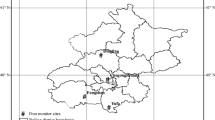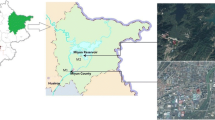Abstract
The rapid economic development and significant expansion of urban agglomerations in China have resulted in issues associated with haze and photochemical smog. Central China, a transitional zone connecting the eastern coast and western interior, suffers from increasing atmospheric pollution. This study performed a spatio-temporal analysis of fine particulate matter (PM2.5) pollution in Changsha, a provincial capital located in central China. Samples of PM2.5 were collected at five different functional areas from September 2013 to August 2014. The PM2.5 concentration at the five sampling sites was the highest in winter and the lowest in summer, with an average annual PM2.5 concentration of 105.2 ± 11.0 μg/m3. On average, residential sites had the highest concentrations of PM2.5 while suburban sites had the lowest. We found that inorganic ionic species were dominant (~48%), organic species occupied approximately 25%, whereas EC (~3.7%) contributed insignificantly to the total PM2.5 mass. Ion balance calculations show that the PM2.5 samples at all sites were acidic, with increased acidity in spring and summer compared with autumn and winter. Air quality in Changsha is controlled by four major air masses: (1) Wuhan and the surrounding urban clusters, (2) the Changsha-Zhuzhou-Xiangtan urban agglomeration and the surrounding cities, and (3) southern and (4) eastern directions. The north–south transport channel is the most significant air mass trajectory in Changsha and has a significant impact on PM2.5 pollution.







Similar content being viewed by others
References
Charlson, R.J., Schwartz, S.E., Hales, J.M., Cess, R.D., Coakley JA Jr, Hansen, J.E., Hofmann, D.J.: Climate forcing by anthropogenic aerosols. Science. 255(5043), 423–430 (1992)
Chen, X.C., Jahn, H.J., Engling, G., et al.: Chemical characterization and sources of personal exposure to fine particulate matter (PM2.5) in the megacity of Guangzhou. China Environ Pollut. 231, 871–881 (2017)
Chow, J.C., Watson, J.G., Fujita, E.M., et al.: Temporal and spatial variations of PM2.5 and PM10 aerosol in the Southern California air quality study. Atmos. Environ. 28(12), 2061–2080 (1994)
Chow, J.C., Watson, J.G., Lu, Z., et al.: Descriptive analysis of PM2.5 and PM10 at regionally representative locations during SJVAQS/AUSPEX. Atmos. Environ. 30(12), 2079–2112 (1996)
Chow, J.C., Watson, J.G., Edgerton, S.A., Vega, E.: Chemical composition of PM2.5 and PM10 in Mexico City during winter 1997. Sci. Total Environ. 287(3), 177–201 (2002)
Draxler, R.R., Hess, G.D.: An overview of the HYSPLIT 4 modelling system for trajectories, dispersion, and deposition. Aust. Meteorol. Mag. 47, 295–308 (1998)
Feng, J., Yu, H., Su, X., et al.: Chemical composition and source apportionment of PM2.5 during Chinese spring festival at Xinxiang, a heavily polluted city in North China: fireworks and health risks. Atmos. Res. 182, 176–188 (2016)
Guan, Y., Kang, L., Wang, Y., et al.: Health loss attributed to PM2.5 pollution in China's cities: economic impact, annual change and reduction potential. J. Clean. Prod. 217, 284–294 (2019)
Guo, S., Hu, M., Wang, Z.B., et al.: Size-resolved aerosol water-soluble ionic compositions in the summer of Beijing: implication of regional secondary formation. Atmos. Chem. Phys. 10(6), 947–959 (2009)
Haywood, J.M., Ramaswamy, V.: Global sensitivity studies of the direct radiative forcing due to anthropogenic sulfate and black carbon aerosols. J. Geophys. Res. Atmos. 103(D6), 6043–6058 (1998)
He, K., Zhao, Q., Ma, Y., et al.: Spatial and seasonal variability of PM2.5 acidity at two Chinese megacities: insights into the formation of secondary inorganic aerosols. Atmos. Chem. Phys. Discuss. 12, 25557–25603 (2012)
Hennigan, C.J., Izumi, J., Sullivan, A.P., et al.: A critical evaluation of proxy methods used to estimate the acidity of atmospheric particles. Atmos. Chem. Phys. 15, 2775–2790 (2015)
Huang, G., Cheng, T., Zhang, R., et al.: Optical properties and chemical composition of PM2.5 in Shanghai in the spring of 2012. Particuology. 13, 52–59 (2014)
Khan, M.F., Shirasuna, Y., Hirano, K., Masunaga, S.: Characterization of PM2.5, PM2.5–10 and PM> 10 in ambient air, Yokohama, Japan. Atmos. Res. 96(1), 159–172 (2010)
Kitto AMN, Harrison RM. Nitrous and nitric acid measurement at site in south-east England, Atmos Environ 26:235-241 (1992)
Lee HS, Wang BW, Chemical characteristics of principal PM2.5 species in Chongju, South Korea, Atmos Environ 35(4):739-746 (2001)
Li, M., Hu, M., Du, B., et al.: Temporal and spatial distribution of PM2.5 chemical composition in a coastal city of Southeast China. Sci. Total Environ. 605, 337–346 (2017)
Lim, H.J., Turpin, B.J.: Origins of primary and secondary organic aerosol in Atlanta: results of time-resolved measurements during the Atlanta supersite experiment. Environ Sci Technol. 36(21), 4489–4496 (2002)
Lin P, Hu M, Deng Z, et al., Seasonal and diurnal variations of organic carbon in PM2.5 in Beijing and the estimation of secondary organic carbon, J Geophys Res-Atmos 114 (D2) (2009)
Liu, L., Wang, Y.L., Du, S.Y., et al.: Single particle analysis during heavy air pollution episodes in January 2014 in Beijing. Acta Sci. Circumst. 34(2), 630–637 (2016) (In Chinese)
Liu, B., Wu, J., Zhang, J., Wang, L., Yang, J., Liang, D., Dai, Q., Bi, X., Feng, Y., Zhang, Y., Zhang, Q.: Characterization and source apportionment of PM2.5 based on error estimation from EPA PMF 5.0 model at a medium city in China. Environ. Pollut. 222, 10–22 (2017)
Ma, Q., Wu, Y., Zhang, D., et al.: Roles of regional transport and heterogeneous reactions in the PM2.5 increase during winter haze episodes in Beijing. Sci. Total Environ. 599, 246–253 (2017)
MEP: The Twelfth Five-Year Plan for Prevention and Control of Atmospheric Pollution in Key Regions. Ministry of Environmental Protection of the People's Republic of China (2012) (in Chinese). http://www.zhb.gov.cn/gkml/hbb/bwj/201212/t20121205_243271.htm
Osada, K., Kido, M., Nishita, C., et al.: Changes in ionic constituents of free tropospheric aerosol particles obtained at Mt. Norikura (2770 m asl), Central Japan, during the Shurin period in 2000. Atmos. Environ. 36(35), 5469–5477 (2002)
Paraskevopoulou, D., Liakakou, E., Gerasopoulos, E., et al.: Sources of atmospheric aerosol from long-term measurements (5 years) of chemical composition in Athens, Greece. Sci. Total Environ. 527, 165–178 (2015)
Qiu, X., Duan, L., Gao, J., Wang, S.L., et al.: Chemical composition and source apportionment of PM10 and PM2.5 in different functional areas of Lanzhou, China. J. Environ. Sci. 40, 75–83 (2016)
Salameh, D., Detournay, A., Pey, J., et al.: PM2.5 chemical composition in five European Mediterranean cities: a 1-year study. Atmos. Res. 155, 102–117 (2015)
Shi, Z., Li, J., Huang, L., et al.: Source apportionment of fine particulate matter in China in 2013 using a source-oriented chemical transport model. Sci. Total Environ. 601, 1476–1487 (2017a)
Shi, G., Xu, J., Peng, X., Xiao, Z., Chen, K., Tian, Y., Guan, X., Feng, Y., Yu, H., Nenes, A., Russell, A.G.: pH of aerosols in a polluted atmosphere: source contributions to highly acidic aerosol. Environ Sci Technol. 51(8), 4289–4296 (2017b)
Tao, J., Zhang, L., Engling, G., et al.: Chemical composition of PM2.5 in an urban environment in Chengdu, China: importance of springtime dust storms and biomass burning. Atmos. Res. 122, 270–283 (2013)
Wang, G., Huang, L., Gao, S., et al.: Characterization of water-soluble species of PM10 and PM2.5 aerosols in urban area in Nanjing, China. Atmos. Environ. 36(8), 1299–1307 (2002)
Wang, Y., Zhuang, G., Tang, A., et al.: The ion chemistry and the source of PM2.5 aerosol in Beijing. Atmos. Environ. 39(21), 3771–3784 (2005)
Wang, X.M., Hua, T., Zhang, C.X., et al.: Aeolian salts in Gobi deserts of the western region of Inner Mongolia: gone with the dust aerosols. Atmos. Res. 118, 1–9 (2012)
Wang, H., Zhu, B., Shen, L., et al.: Water-soluble ions in atmospheric aerosols measured in five sites in the Yangtze River Delta, China: size-fractionated, seasonal variations and sources. Atmos. Environ. 123, 370–379 (2015)
Wang, Y., Jia, C., Tao, J., Zhang, L., Liang, X., Ma, J., Gao, H., Huang, T., Zhang, K.: Chemical characterization and source apportionment of PM2.5 in a semi-arid and petrochemical-industrialized city, Northwest China. Sci. Total Environ. 573, 1031–1040 (2016)
Wang, H.L., Qiao, L.P., Lou, S.R., et al.: Chemical composition of PM2.5 and meteorological impact among three years in urban Shanghai, China. J. Clean. Prod. 112, 1302–1311 (2016a)
Wang, H., An, J., Cheng, M., et al.: One year online measurements of water-soluble ions at the industrially polluted town of Nanjing, China: sources, seasonal and diurnal variations. Chemosphere. 148, 526–536 (2016b)
Watson, J.G., Chow, J.C., Chen, L.W.: Summary of organic and elemental carbon/black carbon analysis methods and Intercomparisons. Aerosol Air Qual. Res. 5, 65–102 (2005)
White, W.H., Roberts, P.T.: On the nature and origins of visibility-reducing aerosols in the Los Angeles air basin. Atmos. Environ. 11(9), 803–812 (1997)
Yan, D., Lei, Y., Shi, Y., et al.: Evolution of the spatiotemporal pattern of PM2.5 concentrations in China–a case study from the Beijing-Tianjin-Hebei region. Atmos. Environ. 183, 225–233 (2018)
Yang, X.Y., Yamada, M., Tang, N., Lin, J.M., Wang, W., Kameda, T., Toriba, A., Hayakawa, K.: Long-range transport of fluoride in East Asia monitored at Noto peninsula, Japan. Sci. Total Environ. 407(16), 4681–4686 (2009)
Yao, L., Garmash, O., Bianchi, F., et al.: Atmospheric new particle formation from sulfuric acid and amines in a Chinese megacity. Science. 361(6399), 278–281 (2018)
Zhang, P., Wu, J.N.: Impact of mandatory targets on PM2.5 concentration control in Chinese cities. J. Clean. Prod. 197, 323–331 (2018)
Zhang, C., Ni, Z., Ni, L.: Multifractal detrended cross-correlation analysis between PM2.5 and meteorological factors. Phys A. 438, 114–123 (2015)
Zhang, Q., Jiang, X., Tong, D., Davis, S.J., Zhao, H., Geng, G., Feng, T., Zheng, B., Lu, Z., Streets, D.G., Ni, R., Brauer, M., van Donkelaar, A., Martin, R.V., Huo, H., Liu, Z., Pan, D., Kan, H., Yan, Y., Lin, J., He, K., Guan, D.: Transboundary health impacts of transported global air pollution and international trade. Nature. 543(7647), 705–709 (2017a)
Zhang, Z., Wang, W., Cheng, M., et al.: The contribution of residential coal combustion to PM2.5 pollution over China's Beijing-Tianjin-Hebei region in winter. Atmos. Environ. 159, 147–161 (2017b)
Zhang, N.N., Ma, F., Qin, C.B., Li, Y.F.: Spatiotemporal trends in PM2.5 levels from 2013 to 2017 and regional demarcations for joint prevention and control of atmospheric pollution in China. Chemosphere. 210, 1176–1184 (2018a)
Zhang, Y., Lang, J., Cheng, S., Li, S., Zhou, Y., Chen, D., Zhang, H., Wang, H.: Chemical composition and sources of PM 1 and PM2.5 in Beijing in autumn. Sci. Total Environ. 630, 72–82 (2018b)
Zhang, W., Wang, F., Hubacek, K., et al.: Unequal exchange of air pollution and economic benefits embodied in China’s exports. Environ Sci Technol. 52(7), 3888–3898 (2018c)
Zheng, Y., Zhang, Q., Liu, Y., et al.: Estimating ground-level PM2.5 concentrations over three megalopolises in China using satellite-derived aerosol optical depth measurements. Atmos. Environ. 124, 232–242 (2016)
Zhou, J., Xing, Z., Deng, J., et al.: Characterizing and sourcing ambient PM2.5 over key emission regions in China I: water-soluble ions and carbonaceous fractions. Atmos. Environ. 135, 20–30 (2016)
Zhou, H., Lü, C., He, J., et al.: Stoichiometry of water-soluble ions in PM2.5: application in source apportionment for a typical industrial city in semi-arid region, Northwest China. Atmos. Res. 204, 149–160 (2018)
Zíková, N., Wang, Y., Yang, F., et al.: On the source contribution to Beijing PM2.5 concentrations. Atmos. Environ. 134, 84–95 (2016)
Zou, Y., Wang, Y., Zhang, Y., et al.: Arctic Sea ice, Eurasia snow, and extreme winter haze in China. Sci. Adv. 3(3), e1602751 (2017)
Acknowledgments
This research was supported by the 13th “Five-Year Plan” Research Fund of the Ministry of Environmental Protection of the People’s Republic of China (Project No. 2110105) and the National Natural Science Foundation of China (Project No. 71441029). The authors would like to thank the Changsha Environmental Monitoring Center for providing the data used during analysis.
Author information
Authors and Affiliations
Corresponding author
Ethics declarations
Conflict of interest
The authors declare no competing financial interests.
Additional information
Publisher’s note
Springer Nature remains neutral with regard to jurisdictional claims in published maps and institutional affiliations.
Rights and permissions
About this article
Cite this article
Zhang, NN., Guan, Y., Yu, L. et al. Spatio-temporal distribution and chemical composition of PM2.5 in Changsha, China. J Atmos Chem 77, 1–16 (2020). https://doi.org/10.1007/s10874-019-09397-y
Received:
Accepted:
Published:
Issue Date:
DOI: https://doi.org/10.1007/s10874-019-09397-y




